Best clip-on guitar tuners 2025: hit the right note with these cost-effective tuners
Whether you play acoustic, electric, or bass, these clip-on tuners offer a quick, easy, and affordable way to achieve concert pitch every time
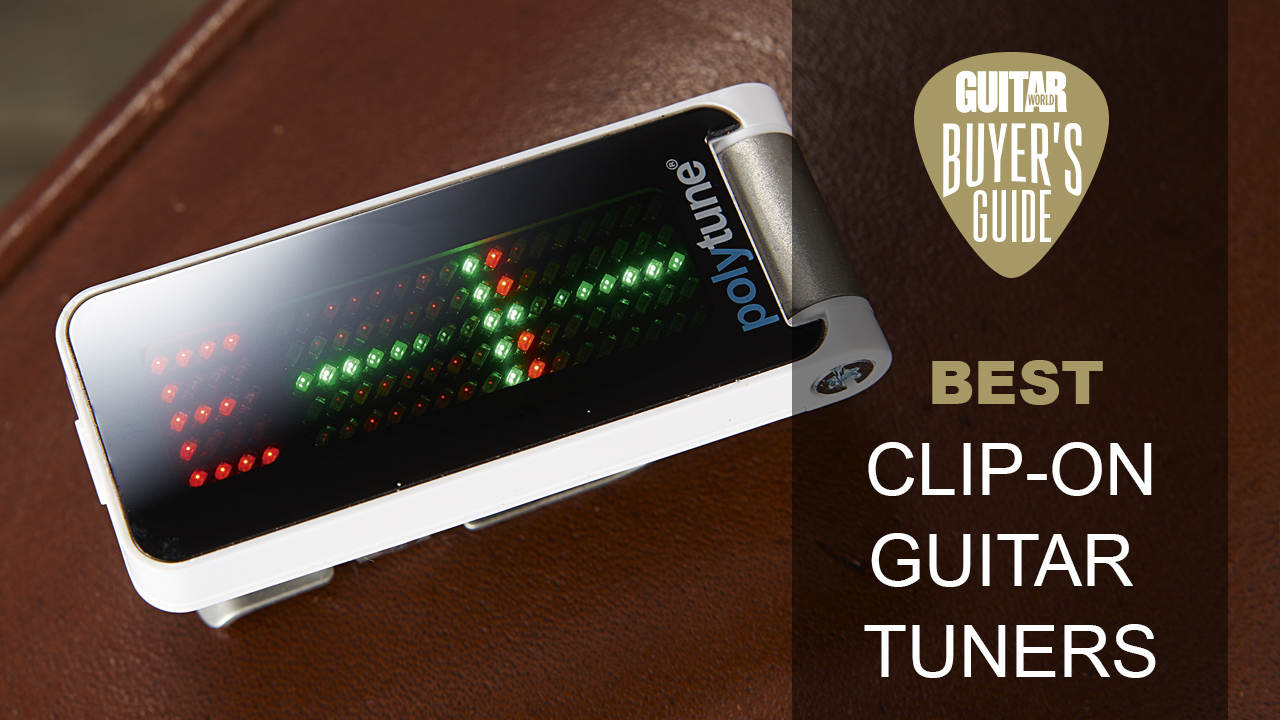
Often thought of as existing purely in the realm of the acoustic guitarist, the best clip-on guitar tuners can work for nearly any stringed instrument, whether you play electric, acoustic, or even bass guitar. You can discretely place one behind the headstock of your instrument, saving you valuable space and a power output on your pedalboard.
Clip-on tuners couldn't be easier to use. Simply attach one to the headstock of your guitar, bass, or ukulele, play a note, check the reading, and bring the string to pitch. Modern clip-on tuners are almost always chromatic, meaning they can detect all 12 notes within an octave. This makes them equally suitable for players exploring open tunings and those sticking to standard tuning.
A clip-on-tuner isn't quite as accurate as a pedal-based one, but ultimately they are far more convenient. So if you're deciding which is best for you, head to our FAQs section where we answer loads of common questions about clip-on tuners. To see the best clip-on tuners you can buy right now, keep on scrolling...
Our top picks
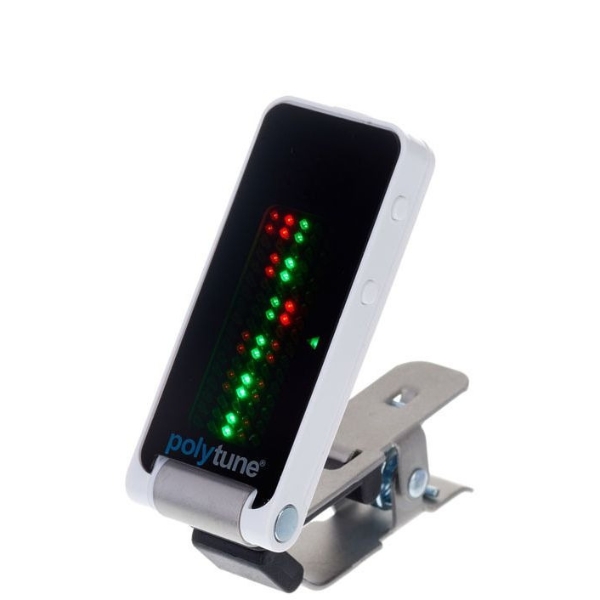
Modes: Polyphonic, chromatic, strobe
Tuning range: A0-C8
Calibration range: A4 = 435Hz-445Hz
Accuracy: +/- 0.02 cent (strobe) 0.5 cents (chromatic)
+ Three tuning modes
+ Bright display
+ Very accurate
- Can damage nitro finishes
The Polytune Clip shows that you don’t need a fancy floor unit to have a lot of features in a tuner. It delivers remarkable performance, with chromatic, strobe, and polyphonic modes that make it a great option for players at all levels.
In chromatic mode, it offers an accuracy of 0.5 cents, which should be more than enough to put your guitar in tune. Strobe mode offers 0.02 cents accuracy, which means it is within one 5,000th of a semitone, which should satisfy most human ears.
The PolyTune Clip is five years old now but still the polytune mode impresses in its ability to display all six strings at once, making on-the-fly adjustments quick and easy. We found the screen to be bright and you get up to 18 hours of battery time.
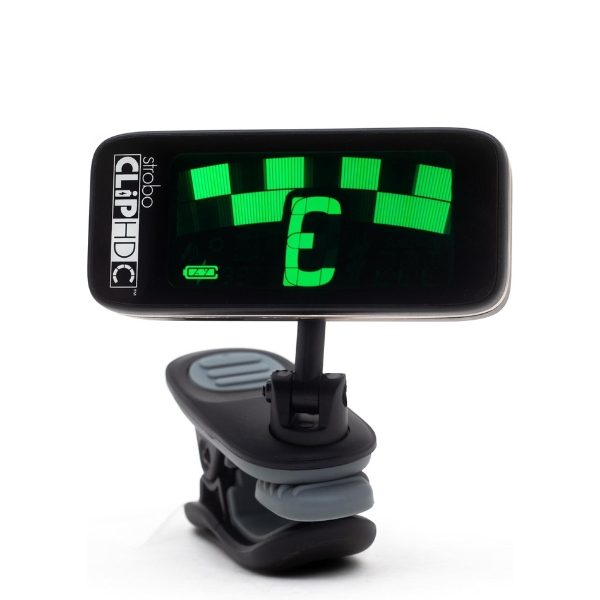
Modes: Strobe
Tuning range: C0-B6
Calibration range: A4 = 390Hz-490Hz
Accuracy: +/- 0.1 cents
+ The most accurate tuner there is
+ Capo and drop tuning settings
+ Excellent build and display
- Strobe mode only
The StroboClip HDC has a huge HD screen, soft rubber-gripped jaws, drop tuning and capo settings, and it utilizes very clever technology not often found in a clip-on tuner. This tuner can accommodate over 50 of Peterson’s sweetened tunings, taking account of the tuning foibles of some of the most popular guitars.
Sweetened tunings take account of how, say, a Telecaster with a three-saddle bridge might wobble in tuning as you fret a chord higher up on the fretboard, and makes the adjustments accordingly. With over 50 different sweetened tunings available, the Stroboclip’s adaptability to different instruments makes this a top contender in its class. Although incredibly professional, this may be overkill for any fresh-faced beginners out there.
Read our full Peterson Stroboclip HDC review
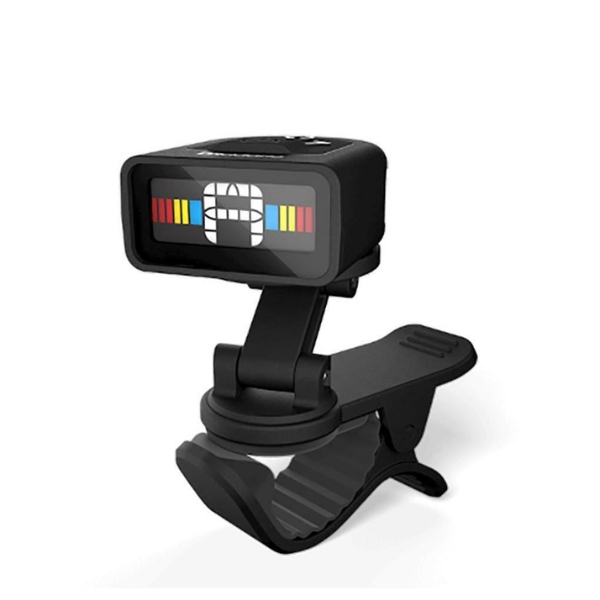
Modes: Chromatic
Tuning range: N/A
Calibration range: A4 = 410-480Hz
Accuracy: +/- 2 cents
+ Small and lightweight
+ Bonus metronome
+ Lots of viewing angles
- Could be too small
The NS Micro Universal has a ratchet clip that allows it to fit discreetly onto pretty much any headstock, front or rear, and it has a 360-degree swivel adjustment and extendable arm to help position it so you can see the LCD screen as you play. Although small in stature, we found the bright LCD makes the tuner a breeze to use, even if your eyesight isn’t what it used to be – blast getting older!
In our experience, it's very light so it won’t tilt your headstock should you wish to keep it on throughout your performance. It’ll tune an electric guitar, but so too a bass, mandolin, banjo and so on, making it a versatile studio companion. There’s a visual metronome mode, too, ideal if your drummer is getting a bit enthusiastic.
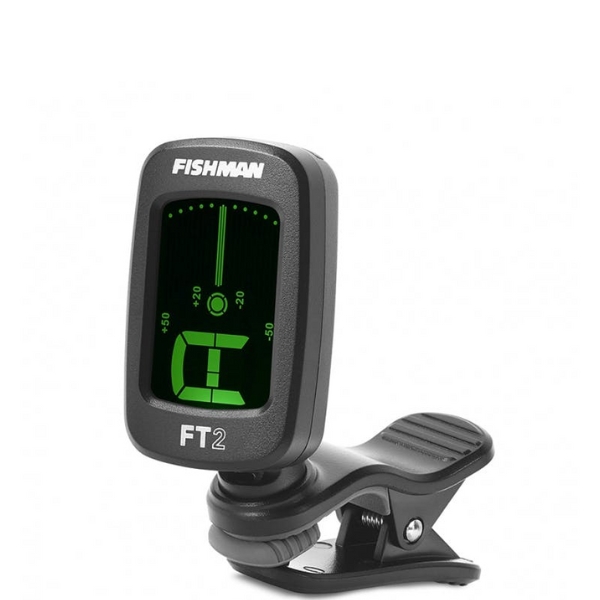
Modes: Chromatic
Tuning range: C0-C8 (16.3-4186Hz)
Calibration range: A4 = 436Hz-445Hz
Accuracy: +/- 1 cent
+ Outstanding value for money
+ Color-coded digital chromatic display
+ Clip is respectful of your guitar’s finish
- Low on features
If you’re looking for a cheap and cheerful clip-on guitar tuner that’s accurate to a cent either way, and you don’t need bells and whistles, the FT-2 is hard to beat. Coming in at around less than 15 bucks, it's a proper bargain.
There is no HD 4K display, no holographic Pokémon to shout out how flat you are, it’s just a tuner. It’s compact and unobtrusive, and it switches itself off after five minutes of inactivity to preserve battery life. What more do you want?
And it’s not like the display doesn’t get the job done. The digital chromatic setup is a breeze; it’s red when you are sharp (which is the worst; you’d rather be flat than sharp), amber when flat, and green when you’re in tune. Simple.
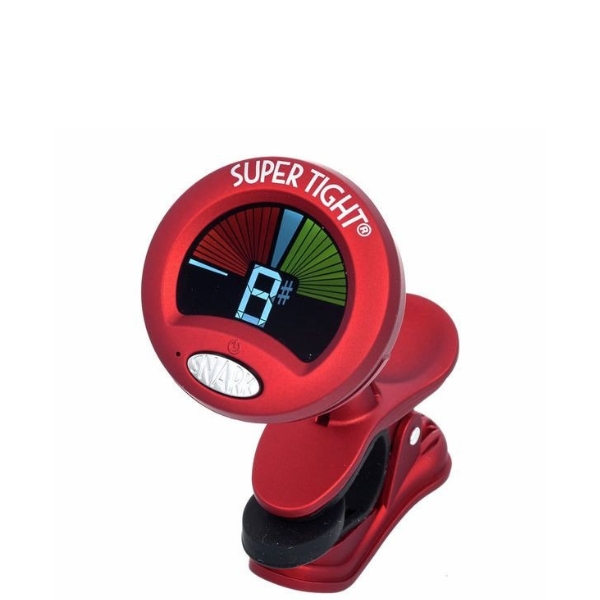
Modes: Chromatic
Tuning range: N/A
Calibration range: A4 = 415Hz-466Hz
Accuracy: N/A
+ Bright display
+ Respectable performance
+ Tunes basses and guitars
- Not for nitro finishes
Snark makes clip-on guitar tuners in many different colors and in many different styles, but there is a recurring theme in that they are all very accessibly-priced and have a bright, colorful screen that makes them visible in low-light situations.
The Super Tight is exactly that. It clamps on tight to your headstock, offering a chromatic tuner that can be switched between microphone mode for tuning acoustic instruments and vibration mode, which uses a transducer.
There is even a tap-tempo metronome mode, which again is an excellent feature at the price. If you’re looking for an entry-level clip-on guitar tuner that’s small enough to throw in the gigbag or jacket pocket, this is a very decent option.
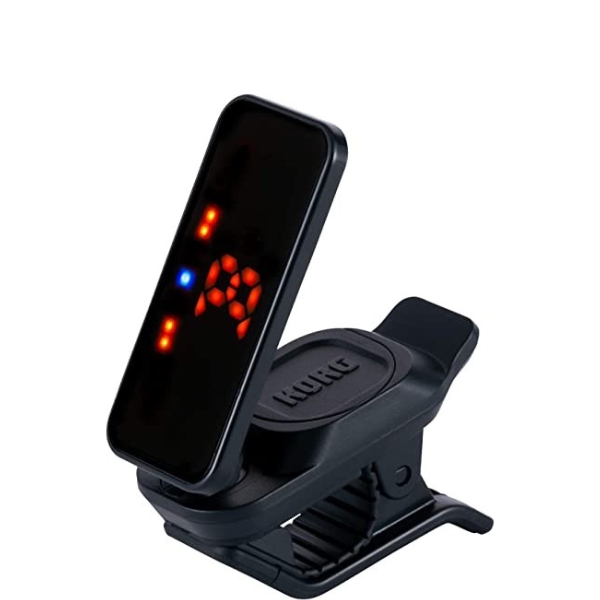
Modes: Chromatic, half-strobe, strobe
Tuning range: A0-C8
Calibration range: A4 = 436Hz–445 Hz
Accuracy: +/- 0.1 cent
+ Super accurate
+ Improved display
+ Reverse display
- Bulky clip
The original Pitchclip has been improved. While the PC2 remains an excellent super-budget option you can pick up for 12 bucks and it’ll be accurate to a cent, the PC2+ has a much better display, offering half-strobe and full-strobe modes.
These new modes improve the accuracy of the tuner tenfold, but perhaps just as important in a tuner with such a compact profile, the PC2+ just seems brighter and more readable in all situations, great for dark stages.
Its display is reversible, making it a decent option for right and left-handed players. It’ll tune a bass, too, and while it doesn’t list the full 24 hours of playing time as its predecessor you’ll get a very respectable 18 hours from one battery.
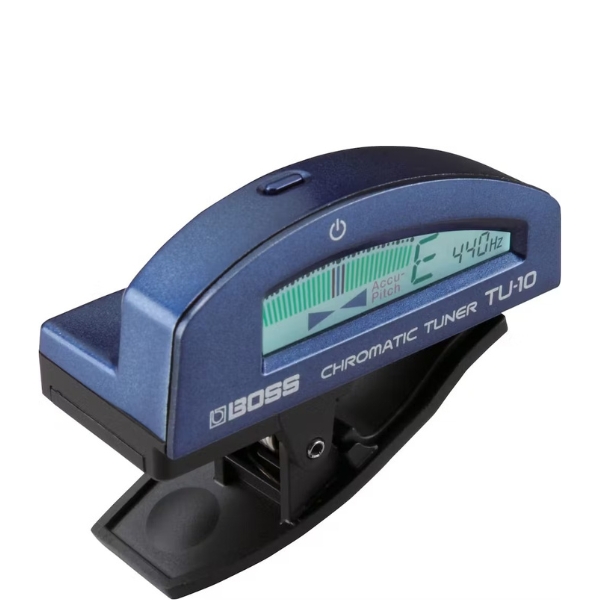
Modes: Chromatic
Tuning range: C0-C8 (16.3-4186Hz)
Calibration range: A4 = 436Hz-445Hz
Accuracy: +/- 1 cent
+ Accurate to a cent
+ Bright display
+ Easy to use
- Only one mode
The Boss TU-10 is a serious tuner despite its simple looks and low price point. At 1 cent accuracy, it’s as accurate as the vast majority of players would need, and it is compact, lightweight, and pretty darn easy to use.
There is a flat tuning mode, where you can tune down up to 5 semitones, making drop and alternate tunings relatively pain-free. Unfortunately, it won't set your guitar up for you, but it's a useful feature for those who like to get low.
The display performs well in a number of low and well-lit scenarios, and it will tune your bass, uke or mandolin too. It’s typical Boss; well-designed, no fuss, player friendly, and for the price that’s a fair degree of functionality and accuracy.
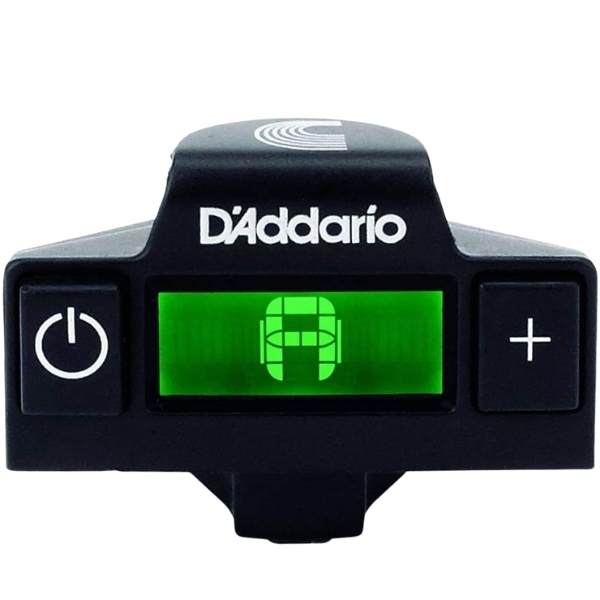
Modes: Chromatic
Tuning range: N/A
Calibration range: A4 = 435Hz-455 Hz
Accuracy: 0.3 cents
+ Very discrete and accurate
+ Multicolor display
+ Fits a variety of acoustics
- Acoustic only
Here is a smart little clip-on guitar tuner for acoustic players. You mount it in your soundhole, so it’s for your eyes only, and when you turn it on you’ll get a bright multicolor display that’s accurate to 0.3 cents.
You can also use it on ukuleles and other acoustic stringed instruments, and the option to calibrate it from 434-445Hz means you can use it with the local orchestra if and when the occasion arises.
Not everyone likes having a clip-on tuner on the headstock, or keeping one there, so the convenience of having this secreted away means you can have it on whenever you need it. It’s easy to operate, quick, and shouldn’t foul up your guitar’s finish.

Modes: Chromatic, strobe, half-strobe
Tuning range: A0–C8
Calibration range: A4 = 436-445 Hz
Accuracy: 0.1 cents
+ Ultra-precise tuning accuracy
+ Easily seen 3D display
+ Premium build quality
- Not rechargeable
With a curved, high-visibility 3D display, the Korg Sledgehammer Pro is ideal if you're after a clip-on tuner for live performances. The curved screen allows you to see the tuner from most angles, meaning if you’re extra rambunctious on stage and likely to knock the tuner out of place, you don't have to faff about readjusting it. The feather in the Sledgehammer’s cap is the shuttle switch which allows you to turn on/off the tuner with one hand, making it even more useful in a live situation.
The Sledgehammer matches the ultra-precise tuning accuracy of Peterson’s StroboClip HD at 0.1 cents, making it incredibly accurate. That tuning accuracy of 0.1 cents is available across all chromatic, strobe and half-strobe modes.
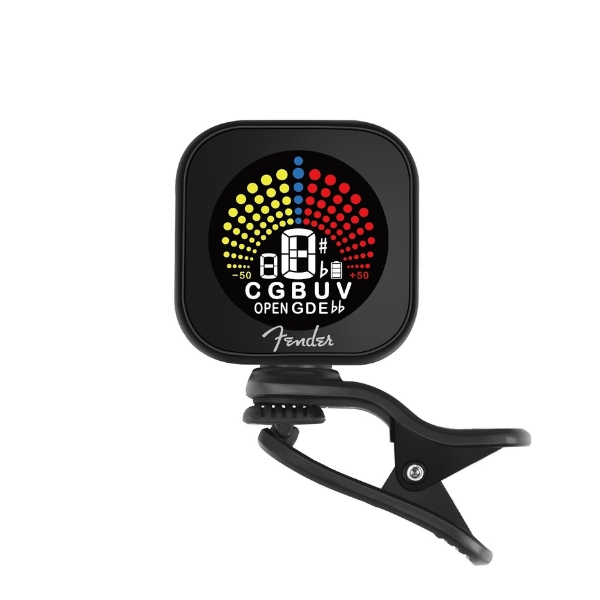
Modes: Chromatic
Tuning range: A0
Calibration range: A4 = 436-445 Hz
Accuracy: 1 cents
+ Rechargeable battery
+ Auto shutdown
+ Incredibly bright screen
- Only chromatic mode
In today's world, it's surprising that many clip-on tuners still rely on battery power. Those small circular watch batteries can be a hassle to replace, costly, and far from environmentally friendly. Plus, they’re pretty unreliable—there’s nothing worse than being struck by inspiration, reaching for your tuner, and finding it completely dead. Enter the Fender Flash 2.0 clip-on tuner.
This user-friendly little tuner is USB rechargeable, so you’ll never have to make a last-minute trip to the store for batteries again. With an impressive 20-hour battery life, it’s one of the longest-lasting tuners in our guide. Plus, if you’re prone to forgetting, the auto shutdown feature ensures the battery won’t drain while it’s sitting in your gig bag.
As a chromatic tuner, it works with most stringed instruments—guitar, bass, ukulele, mandolin, and more. The super bright LED screen makes it easy to read, and with two 360-degree rotating swivels and a 120-degree hinge, you can position it on the front or back of the headstock to suit your preference, making the Fender Flash 2.0 incredibly versatile.
How to choose
All of the clip-on tuners in this guide will do a good job on multiple instruments, but there is a little more to it than that when deciding what's best for you. To help you choose here's some more information on the types of tuner available and how they operate.
Chromatic tuners
You can trust Guitar World
Perhaps the most common is the chromatic tuner. Here you play one note at a time and the tuner can tune to each of the 12 notes of Western music’s chromatic scale. The display might either show a needle or LED, typically showing green when you reach pitch.
Polyphonic tuner
Then you’ve got the polyphonic tuner. These allow you to play all six strings simultaneously and will display which notes are in tune and which are not. For quickly identifying tuning problems, there’s nothing better, and it’ll save you going string to string as with a chromatic tuner. This is a great option when time is of the essence, such as during a gig, or a recording session where the clock is ticking.
Strobe tuner
Finally, you’ve got the strobe tuner, the most accurate and the most expensive of the options available. If they can be a little bit fiddly to operate at first – with the tuner displaying a spinning circle of the reference note and the note that you’ve picked, and you’ve got to tune very carefully until the display registers the correct pitch - the accuracy is incredible.
Which clip-on guitar tuner is right for your needs depends on a number of factors, but we’d say that if you are a beginner, and likely to be playing a beginner’s guitar, you might be better off using a chromatic tuner. They will be cheaper, easier to use and a quality chromatic tuner will be accurate enough to make your guitar sound in tune.
Pros would no doubt be better off with a strobe tuner, especially in the studio, but if your ear cannot pick up that amount of accuracy, is there any point in spending the extra money?
FAQs
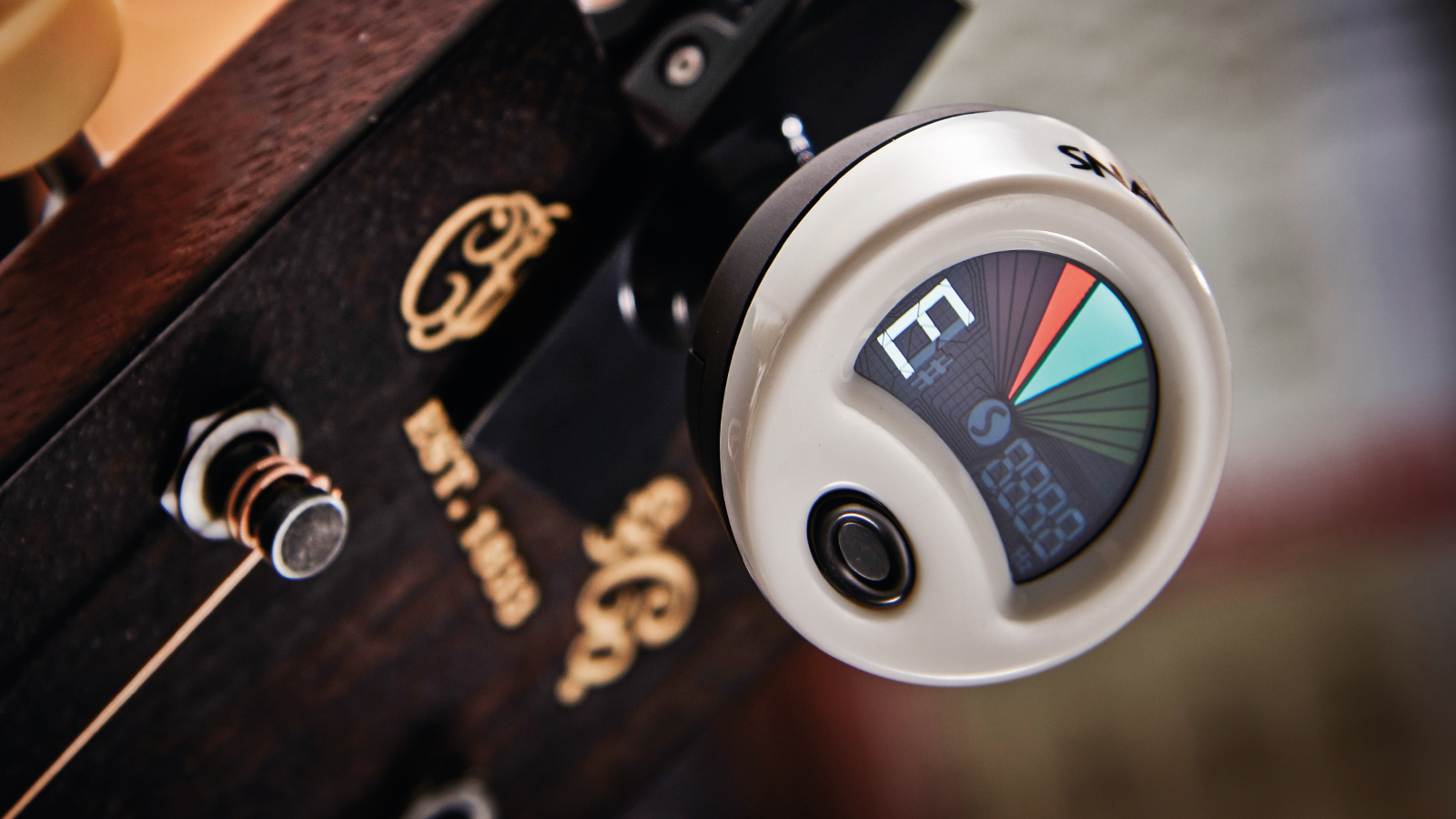
Why do I need a clip-on guitar tuner?
That’s easy – because you are not a sadist and you wish to keep your bandmates and audience sane! There’s nothing worse than an out-of-tune guitar, or indeed the sound of a guitar tuning up.
In the past, we might have tuned by ear to a tuning fork or reference pitch, and that was more or less good enough for rock’n’roll, but this approach takes training of the ear to be anywhere near accurate. And besides, your tuner will help you make adjustments to your guitar’s intonation – so it can be in tune at all – and facilitate alternate tunings if that’s your bag. There’s no question that a tuner is an essential tool for 99% of guitarists out there.
Are clip-on guitar tuners any good?
That’s a good question. For acoustic guitar players, it’s a no-brainer. Some acoustic-electric guitars will have an onboard tuner in their pickup and preamp system, but otherwise a clip-on is your best bet.
For electric guitar players it is a little more complicated. Of course, you could stay in tune with a pedal tuner, or with a fancy rack-mounted unit like the Korg Pitchblack Pro, but let’s imagine your pedalboard is already overcrowded as it is. Removing the tuner would free up some valuable real estate for, ooh, an analog delay pedal, for example. The clip-on tuner could make that a reality.
There are other advantages besides pedalboard space. Using a clip-on tuner takes out another variable in your signal chain; you won’t need another patch cable, it’s less cable to go through, and if you’ve got a long and complicated signal chain there’s fewer worries about high-end roll-off or other neurotic considerations that keep guitarists awake at night.
Another practical consideration, and we’re definitely not cork-sniffing here, is that the clip-on guitar tuner is portable, typically taking a lithium-ion battery. You can keep it in your case or in some cases your pocket. Share it with your bandmates; if you have a ukulele or bass guitar player in your ranks, it will tune them up, too. And if everyone is using the same tuner, then you’re all tuning to the same standard and your jam sessions will be even more harmonious.
Now, a quick word of caution if you own a vintage acoustic or a very high-end instrument with a delicate nitrocellulose lacquer finish: some manufacturers, such as Snark, recommend that you don’t use them with fine finishes. While most clip-ons should be okay for all finishes, it’s always best to check it is suitable for your guitar’s finish before taking the plunge.
How accurate are clip-on guitar tuners?
Here’s the elephant in the room; your guitar is never in tune. At least, not totally, and that is because stringed instruments are volatile.
Stringed instruments are dealing with a lot of frequencies, a lot of reverberations, and your tuning depends on a number of factors, not least your setup. You want your intonation to be bang on so that fretted notes sound as in-tune as open notes, but that is not always achievable, and is often contingent on your guitar’s construction.
Then there is your playing style. The harder you hit the strings, the more you will pop in and out of tune. You can see this whenever you play a string through a tuner, whenever you play a note it goes sharp before returning to pitch.
Should this worry you? To a degree, yes. We should always be striving for accuracy, for our intonation to be set up correctly.
A tuner’s accuracy is measured in cents. You’ll see this a lot in the recommendations in this buyer’s guide. A cent is a hundredth of a semitone. So if a tuner is accurate to 2 cents it is accurate to within 2/100 of a semitone with a 4-cent swing either way. When you factor in the other five strings, there could be a noticeable difference in a guitar that is “in tune” according to a tuner with a 2-cent accuracy and one that is “in tune” to a 0.02 cent accuracy.
Again, this is a question of how good your ear is. What might send a producer to the restroom crying might sound perfect to 99 percent of the audience.
We’ve included the accuracy stats for our top picks in this guide to help match you with the write tuner for your needs.
How do you use a clip-on guitar tuner?
Using a clip-on guitar tuner couldn't be easier. Simply attach the tuner to the headstock of your guitar and pluck the string you wish to tune. The screen will then light up, showing you if you need to sharpen or flatten the note - that's it!
The clip-on guitar tuner uses either a sensor – a piezo-style transducer – to pick up the string's vibration through the guitar's body, it then processes the note using its software and displays the note on a screen. This makes the clip-on tuner ideal for when there is a lot of external noise, such as on-stage during a gig or when you need to tune-up at a band rehearsal.
Are clip-on tuners effective with bass guitar?
Absolutely! A good-quality clip-on tuner can handle the low notes on a bass guitar just fine. That said, some of the cheaper options might struggle with the extra-low frequencies. If that happens, try hitting the natural harmonic at the 12th fret—it usually does the trick. Stick to reliable picks like the Peterson or TC Electronic tuners on our list, and you’ll be all set.
How we choose products for this guide
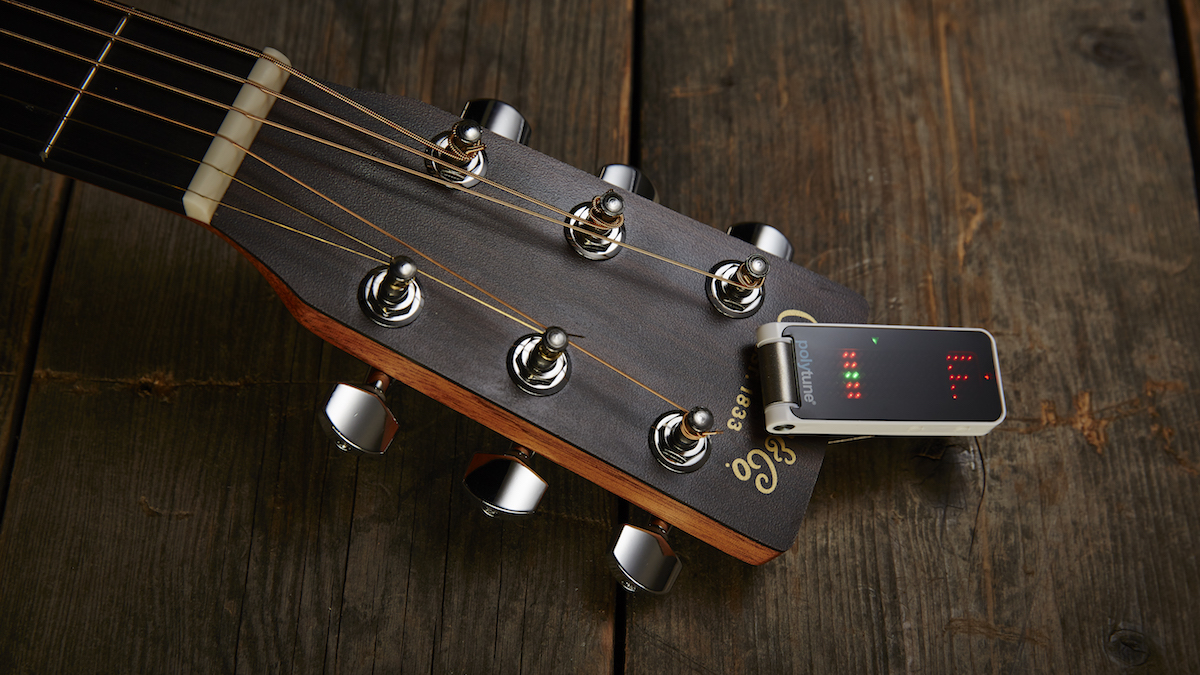
Here at Guitar World, we are experts in our field, with many years of playing and product testing between us all. We live and breathe everything guitar and bass related, and we draw on this knowledge and experience of using products in live, recording and rehearsal scenarios when selecting the products for our guides.
When choosing what we believe to be the best clip-on guitar tuners available right now, we combine our hands-on experience, user reviews and testimonies and engage in lengthy discussions with our editorial colleagues to reach a consensus about the top products in any given category.
First and foremost, we are guitarists, and we want other players to find the right product for them. So we take into careful consideration everything from budget to feature set, ease of use and durability to come up with a list of what we can safely say are the best clip-on guitar tuners on the market right now.
Read more about our rating system, how we choose the gear we feature, and exactly how we test each product.
More guitar guides to explore
- Just starting out? These are the best acoustic guitars for beginners
- And the best beginner electric guitars
- Take a look at some of the best gifts for guitar players
- Secure your axe with the best guitar strap locks
- Boost playing comfort with the best guitar straps
Get The Pick Newsletter
All the latest guitar news, interviews, lessons, reviews, deals and more, direct to your inbox!
Jonathan Horsley has been writing about guitars since 2005, playing them since 1990, and regularly contributes to publications including Guitar World, MusicRadar and Total Guitar. He uses Jazz III nylon picks, 10s during the week, 9s at the weekend, and shamefully still struggles with rhythm figure one of Van Halen’s Panama.
- Matt McCrackenJunior Deals Writer
- Ross Holder
“Add a dash of smokin’ style to your tuning game”: Keef and Clapton fans, rejoice – Tunerette honors the heyday of rock ‘n’ roll with a clip-on tuner that looks like a cigarette
"This is an excellent, compact pedal that helps you tune accurately and quickly": Peterson StroboStomp Mini review











